Human Capital Management and Leadership Analysis for Aviva
VerifiedAdded on 2020/10/05
|17
|5030
|387
Report
AI Summary
This report provides a comprehensive analysis of Aviva's human capital management and leadership practices. It begins with an abstract and introduction, setting the stage for an examination of various models and theories applied by Aviva in managing its human resources, including the Harvard Model and administrative theory. The report delves into Aviva's recruitment and selection processes, offering strategic human resource initiatives and recommendations for improvement. It then discusses Aviva's approach to Human Resource Development (HRD) and suggests enhancements. Furthermore, the report evaluates classical theories of motivation and proposes a hybrid theory. It concludes with a discussion of the characteristics of effective leaders. The study covers topics such as recruitment planning, strategy formulation, and the use of internal and external recruitment sources, highlighting areas for improvement like increased utilization of social media and providing more specific job information. The HRD section focuses on training programs, e-learning modules, and the development of employee skills. The report synthesizes various management theories and their practical application within the context of Aviva's operations.
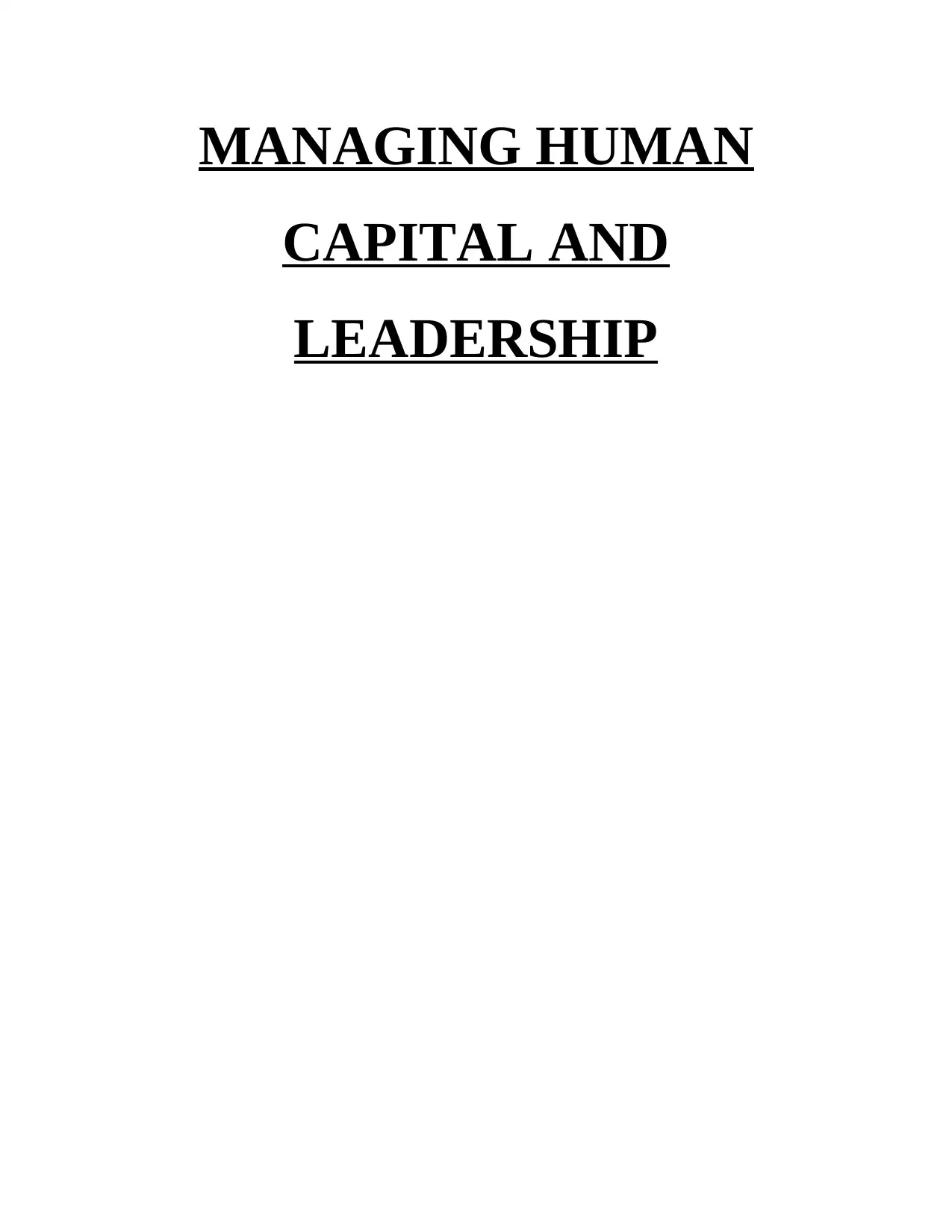
MANAGING HUMAN
CAPITAL AND
LEADERSHIP
CAPITAL AND
LEADERSHIP
Paraphrase This Document
Need a fresh take? Get an instant paraphrase of this document with our AI Paraphraser
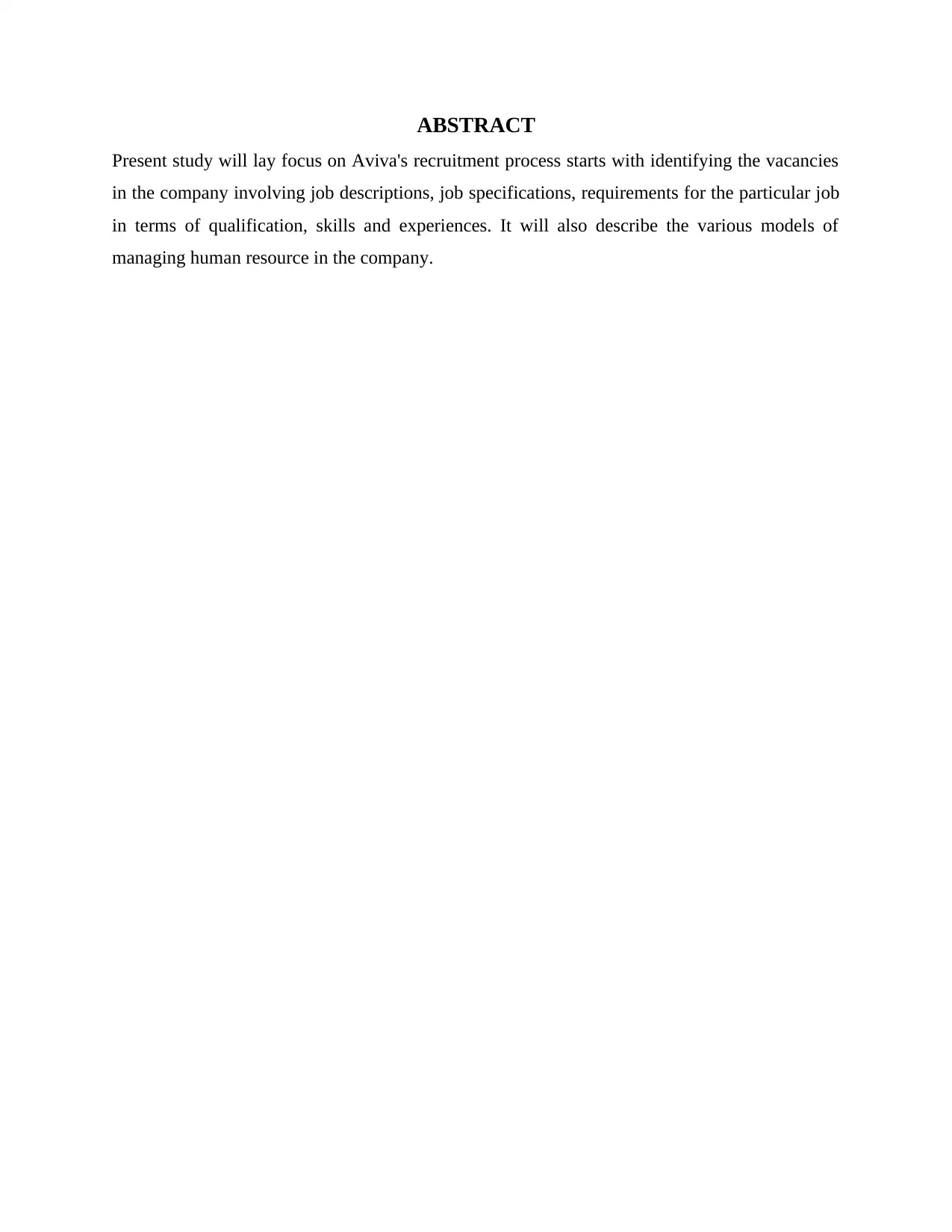
ABSTRACT
Present study will lay focus on Aviva's recruitment process starts with identifying the vacancies
in the company involving job descriptions, job specifications, requirements for the particular job
in terms of qualification, skills and experiences. It will also describe the various models of
managing human resource in the company.
Present study will lay focus on Aviva's recruitment process starts with identifying the vacancies
in the company involving job descriptions, job specifications, requirements for the particular job
in terms of qualification, skills and experiences. It will also describe the various models of
managing human resource in the company.
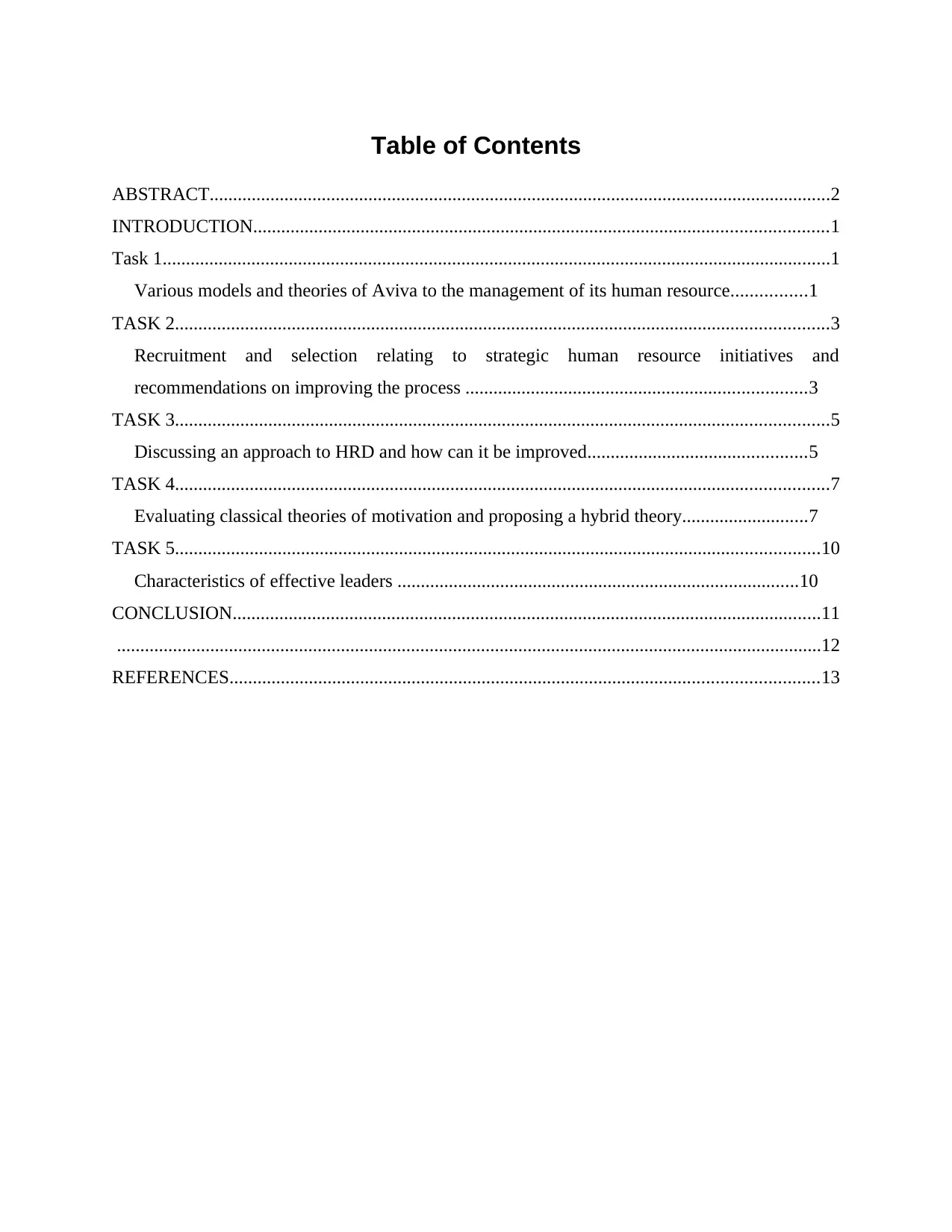
Table of Contents
ABSTRACT.....................................................................................................................................2
INTRODUCTION...........................................................................................................................1
Task 1...............................................................................................................................................1
Various models and theories of Aviva to the management of its human resource................1
TASK 2............................................................................................................................................3
Recruitment and selection relating to strategic human resource initiatives and
recommendations on improving the process .........................................................................3
TASK 3............................................................................................................................................5
Discussing an approach to HRD and how can it be improved...............................................5
TASK 4............................................................................................................................................7
Evaluating classical theories of motivation and proposing a hybrid theory...........................7
TASK 5..........................................................................................................................................10
Characteristics of effective leaders ......................................................................................10
CONCLUSION..............................................................................................................................11
.......................................................................................................................................................12
REFERENCES..............................................................................................................................13
ABSTRACT.....................................................................................................................................2
INTRODUCTION...........................................................................................................................1
Task 1...............................................................................................................................................1
Various models and theories of Aviva to the management of its human resource................1
TASK 2............................................................................................................................................3
Recruitment and selection relating to strategic human resource initiatives and
recommendations on improving the process .........................................................................3
TASK 3............................................................................................................................................5
Discussing an approach to HRD and how can it be improved...............................................5
TASK 4............................................................................................................................................7
Evaluating classical theories of motivation and proposing a hybrid theory...........................7
TASK 5..........................................................................................................................................10
Characteristics of effective leaders ......................................................................................10
CONCLUSION..............................................................................................................................11
.......................................................................................................................................................12
REFERENCES..............................................................................................................................13
⊘ This is a preview!⊘
Do you want full access?
Subscribe today to unlock all pages.

Trusted by 1+ million students worldwide
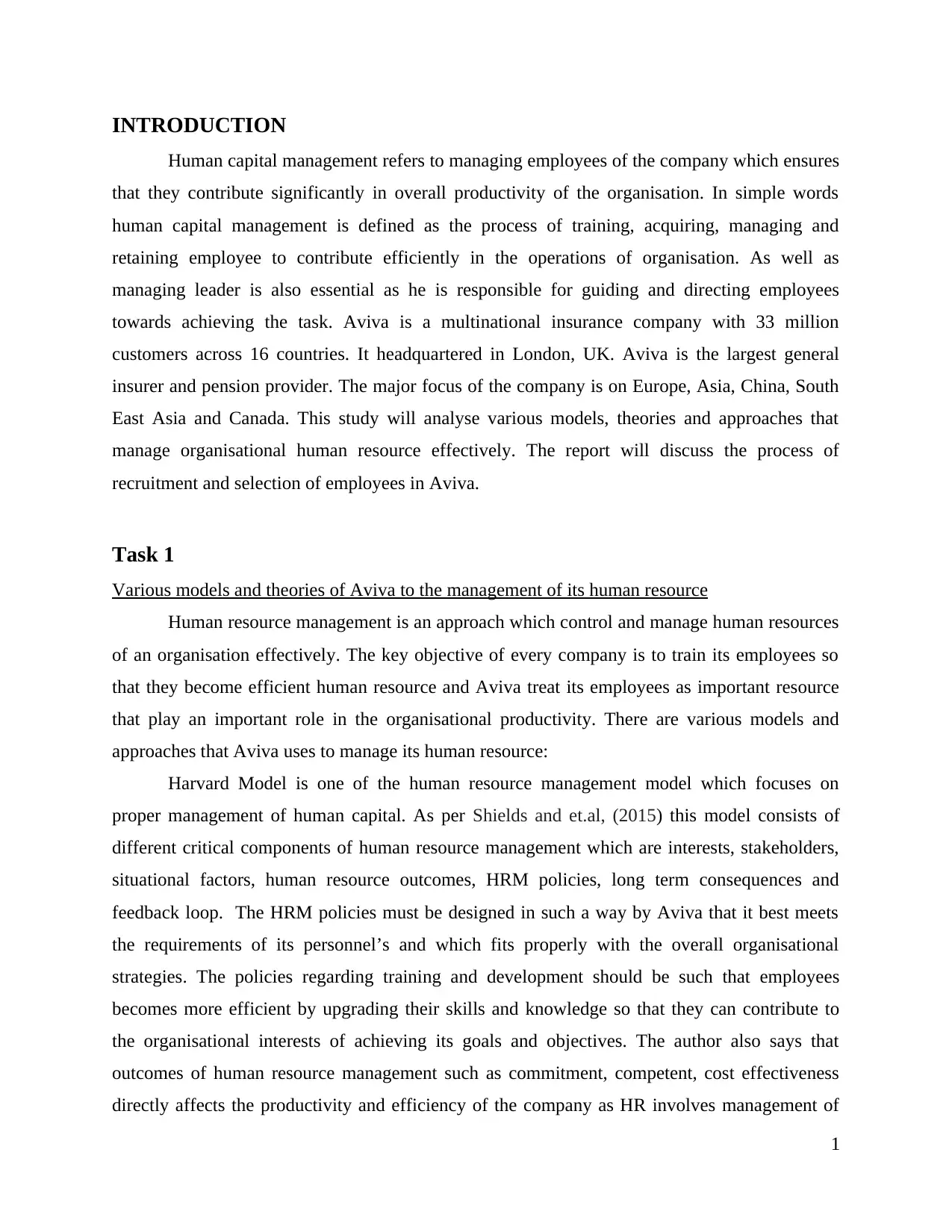
INTRODUCTION
Human capital management refers to managing employees of the company which ensures
that they contribute significantly in overall productivity of the organisation. In simple words
human capital management is defined as the process of training, acquiring, managing and
retaining employee to contribute efficiently in the operations of organisation. As well as
managing leader is also essential as he is responsible for guiding and directing employees
towards achieving the task. Aviva is a multinational insurance company with 33 million
customers across 16 countries. It headquartered in London, UK. Aviva is the largest general
insurer and pension provider. The major focus of the company is on Europe, Asia, China, South
East Asia and Canada. This study will analyse various models, theories and approaches that
manage organisational human resource effectively. The report will discuss the process of
recruitment and selection of employees in Aviva.
Task 1
Various models and theories of Aviva to the management of its human resource
Human resource management is an approach which control and manage human resources
of an organisation effectively. The key objective of every company is to train its employees so
that they become efficient human resource and Aviva treat its employees as important resource
that play an important role in the organisational productivity. There are various models and
approaches that Aviva uses to manage its human resource:
Harvard Model is one of the human resource management model which focuses on
proper management of human capital. As per Shields and et.al, (2015) this model consists of
different critical components of human resource management which are interests, stakeholders,
situational factors, human resource outcomes, HRM policies, long term consequences and
feedback loop. The HRM policies must be designed in such a way by Aviva that it best meets
the requirements of its personnel’s and which fits properly with the overall organisational
strategies. The policies regarding training and development should be such that employees
becomes more efficient by upgrading their skills and knowledge so that they can contribute to
the organisational interests of achieving its goals and objectives. The author also says that
outcomes of human resource management such as commitment, competent, cost effectiveness
directly affects the productivity and efficiency of the company as HR involves management of
1
Human capital management refers to managing employees of the company which ensures
that they contribute significantly in overall productivity of the organisation. In simple words
human capital management is defined as the process of training, acquiring, managing and
retaining employee to contribute efficiently in the operations of organisation. As well as
managing leader is also essential as he is responsible for guiding and directing employees
towards achieving the task. Aviva is a multinational insurance company with 33 million
customers across 16 countries. It headquartered in London, UK. Aviva is the largest general
insurer and pension provider. The major focus of the company is on Europe, Asia, China, South
East Asia and Canada. This study will analyse various models, theories and approaches that
manage organisational human resource effectively. The report will discuss the process of
recruitment and selection of employees in Aviva.
Task 1
Various models and theories of Aviva to the management of its human resource
Human resource management is an approach which control and manage human resources
of an organisation effectively. The key objective of every company is to train its employees so
that they become efficient human resource and Aviva treat its employees as important resource
that play an important role in the organisational productivity. There are various models and
approaches that Aviva uses to manage its human resource:
Harvard Model is one of the human resource management model which focuses on
proper management of human capital. As per Shields and et.al, (2015) this model consists of
different critical components of human resource management which are interests, stakeholders,
situational factors, human resource outcomes, HRM policies, long term consequences and
feedback loop. The HRM policies must be designed in such a way by Aviva that it best meets
the requirements of its personnel’s and which fits properly with the overall organisational
strategies. The policies regarding training and development should be such that employees
becomes more efficient by upgrading their skills and knowledge so that they can contribute to
the organisational interests of achieving its goals and objectives. The author also says that
outcomes of human resource management such as commitment, competent, cost effectiveness
directly affects the productivity and efficiency of the company as HR involves management of
1
Paraphrase This Document
Need a fresh take? Get an instant paraphrase of this document with our AI Paraphraser
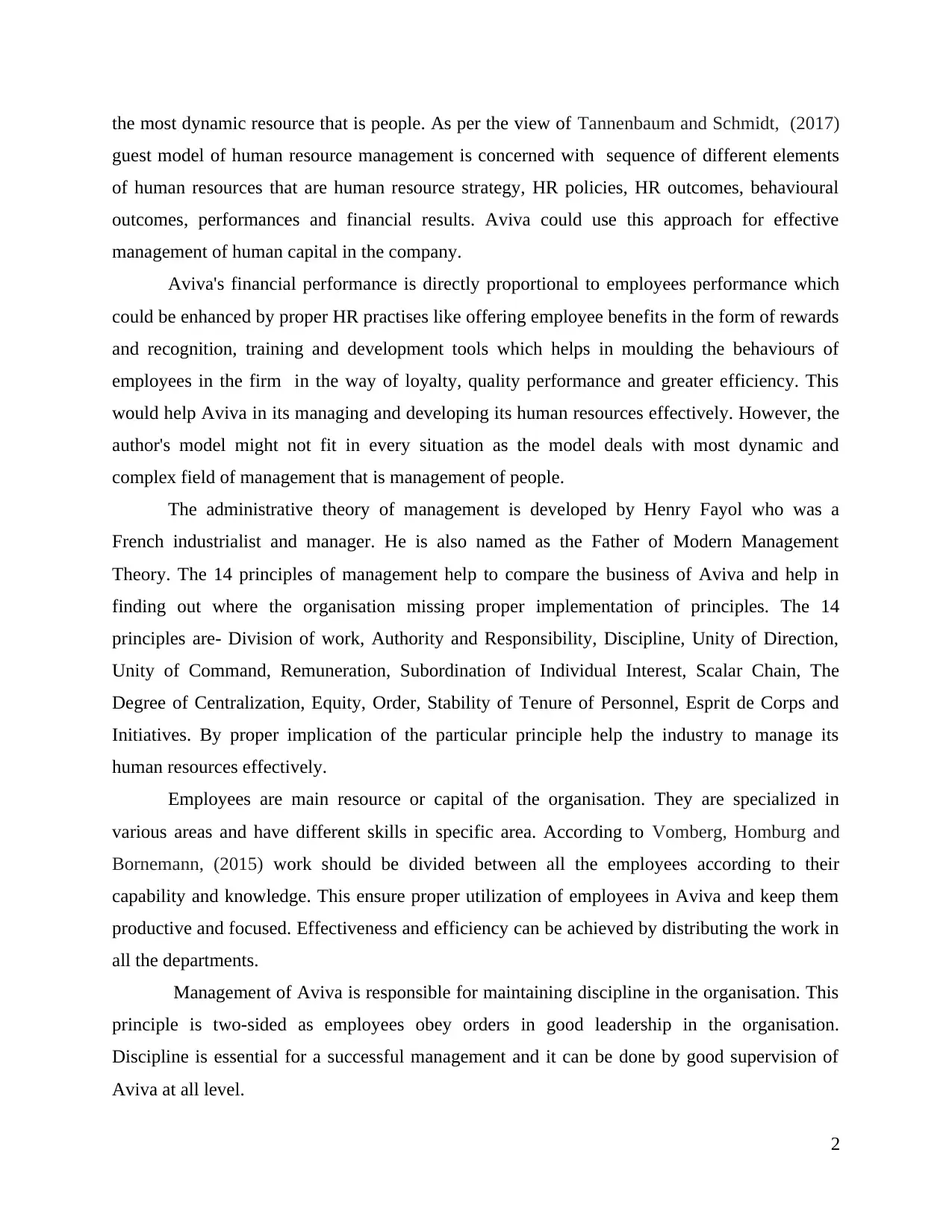
the most dynamic resource that is people. As per the view of Tannenbaum and Schmidt, (2017)
guest model of human resource management is concerned with sequence of different elements
of human resources that are human resource strategy, HR policies, HR outcomes, behavioural
outcomes, performances and financial results. Aviva could use this approach for effective
management of human capital in the company.
Aviva's financial performance is directly proportional to employees performance which
could be enhanced by proper HR practises like offering employee benefits in the form of rewards
and recognition, training and development tools which helps in moulding the behaviours of
employees in the firm in the way of loyalty, quality performance and greater efficiency. This
would help Aviva in its managing and developing its human resources effectively. However, the
author's model might not fit in every situation as the model deals with most dynamic and
complex field of management that is management of people.
The administrative theory of management is developed by Henry Fayol who was a
French industrialist and manager. He is also named as the Father of Modern Management
Theory. The 14 principles of management help to compare the business of Aviva and help in
finding out where the organisation missing proper implementation of principles. The 14
principles are- Division of work, Authority and Responsibility, Discipline, Unity of Direction,
Unity of Command, Remuneration, Subordination of Individual Interest, Scalar Chain, The
Degree of Centralization, Equity, Order, Stability of Tenure of Personnel, Esprit de Corps and
Initiatives. By proper implication of the particular principle help the industry to manage its
human resources effectively.
Employees are main resource or capital of the organisation. They are specialized in
various areas and have different skills in specific area. According to Vomberg, Homburg and
Bornemann, (2015) work should be divided between all the employees according to their
capability and knowledge. This ensure proper utilization of employees in Aviva and keep them
productive and focused. Effectiveness and efficiency can be achieved by distributing the work in
all the departments.
Management of Aviva is responsible for maintaining discipline in the organisation. This
principle is two-sided as employees obey orders in good leadership in the organisation.
Discipline is essential for a successful management and it can be done by good supervision of
Aviva at all level.
2
guest model of human resource management is concerned with sequence of different elements
of human resources that are human resource strategy, HR policies, HR outcomes, behavioural
outcomes, performances and financial results. Aviva could use this approach for effective
management of human capital in the company.
Aviva's financial performance is directly proportional to employees performance which
could be enhanced by proper HR practises like offering employee benefits in the form of rewards
and recognition, training and development tools which helps in moulding the behaviours of
employees in the firm in the way of loyalty, quality performance and greater efficiency. This
would help Aviva in its managing and developing its human resources effectively. However, the
author's model might not fit in every situation as the model deals with most dynamic and
complex field of management that is management of people.
The administrative theory of management is developed by Henry Fayol who was a
French industrialist and manager. He is also named as the Father of Modern Management
Theory. The 14 principles of management help to compare the business of Aviva and help in
finding out where the organisation missing proper implementation of principles. The 14
principles are- Division of work, Authority and Responsibility, Discipline, Unity of Direction,
Unity of Command, Remuneration, Subordination of Individual Interest, Scalar Chain, The
Degree of Centralization, Equity, Order, Stability of Tenure of Personnel, Esprit de Corps and
Initiatives. By proper implication of the particular principle help the industry to manage its
human resources effectively.
Employees are main resource or capital of the organisation. They are specialized in
various areas and have different skills in specific area. According to Vomberg, Homburg and
Bornemann, (2015) work should be divided between all the employees according to their
capability and knowledge. This ensure proper utilization of employees in Aviva and keep them
productive and focused. Effectiveness and efficiency can be achieved by distributing the work in
all the departments.
Management of Aviva is responsible for maintaining discipline in the organisation. This
principle is two-sided as employees obey orders in good leadership in the organisation.
Discipline is essential for a successful management and it can be done by good supervision of
Aviva at all level.
2
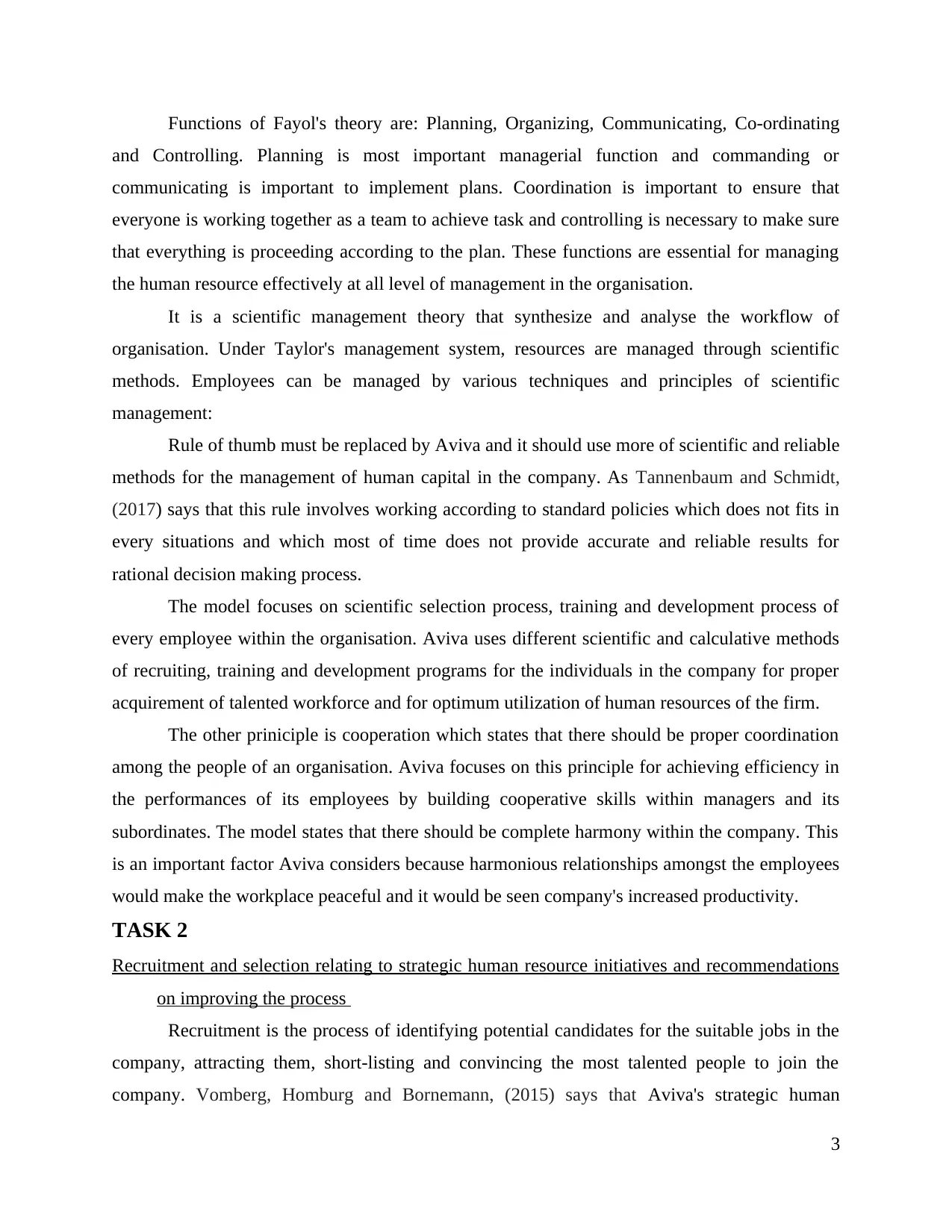
Functions of Fayol's theory are: Planning, Organizing, Communicating, Co-ordinating
and Controlling. Planning is most important managerial function and commanding or
communicating is important to implement plans. Coordination is important to ensure that
everyone is working together as a team to achieve task and controlling is necessary to make sure
that everything is proceeding according to the plan. These functions are essential for managing
the human resource effectively at all level of management in the organisation.
It is a scientific management theory that synthesize and analyse the workflow of
organisation. Under Taylor's management system, resources are managed through scientific
methods. Employees can be managed by various techniques and principles of scientific
management:
Rule of thumb must be replaced by Aviva and it should use more of scientific and reliable
methods for the management of human capital in the company. As Tannenbaum and Schmidt,
(2017) says that this rule involves working according to standard policies which does not fits in
every situations and which most of time does not provide accurate and reliable results for
rational decision making process.
The model focuses on scientific selection process, training and development process of
every employee within the organisation. Aviva uses different scientific and calculative methods
of recruiting, training and development programs for the individuals in the company for proper
acquirement of talented workforce and for optimum utilization of human resources of the firm.
The other priniciple is cooperation which states that there should be proper coordination
among the people of an organisation. Aviva focuses on this principle for achieving efficiency in
the performances of its employees by building cooperative skills within managers and its
subordinates. The model states that there should be complete harmony within the company. This
is an important factor Aviva considers because harmonious relationships amongst the employees
would make the workplace peaceful and it would be seen company's increased productivity.
TASK 2
Recruitment and selection relating to strategic human resource initiatives and recommendations
on improving the process
Recruitment is the process of identifying potential candidates for the suitable jobs in the
company, attracting them, short-listing and convincing the most talented people to join the
company. Vomberg, Homburg and Bornemann, (2015) says that Aviva's strategic human
3
and Controlling. Planning is most important managerial function and commanding or
communicating is important to implement plans. Coordination is important to ensure that
everyone is working together as a team to achieve task and controlling is necessary to make sure
that everything is proceeding according to the plan. These functions are essential for managing
the human resource effectively at all level of management in the organisation.
It is a scientific management theory that synthesize and analyse the workflow of
organisation. Under Taylor's management system, resources are managed through scientific
methods. Employees can be managed by various techniques and principles of scientific
management:
Rule of thumb must be replaced by Aviva and it should use more of scientific and reliable
methods for the management of human capital in the company. As Tannenbaum and Schmidt,
(2017) says that this rule involves working according to standard policies which does not fits in
every situations and which most of time does not provide accurate and reliable results for
rational decision making process.
The model focuses on scientific selection process, training and development process of
every employee within the organisation. Aviva uses different scientific and calculative methods
of recruiting, training and development programs for the individuals in the company for proper
acquirement of talented workforce and for optimum utilization of human resources of the firm.
The other priniciple is cooperation which states that there should be proper coordination
among the people of an organisation. Aviva focuses on this principle for achieving efficiency in
the performances of its employees by building cooperative skills within managers and its
subordinates. The model states that there should be complete harmony within the company. This
is an important factor Aviva considers because harmonious relationships amongst the employees
would make the workplace peaceful and it would be seen company's increased productivity.
TASK 2
Recruitment and selection relating to strategic human resource initiatives and recommendations
on improving the process
Recruitment is the process of identifying potential candidates for the suitable jobs in the
company, attracting them, short-listing and convincing the most talented people to join the
company. Vomberg, Homburg and Bornemann, (2015) says that Aviva's strategic human
3
⊘ This is a preview!⊘
Do you want full access?
Subscribe today to unlock all pages.

Trusted by 1+ million students worldwide
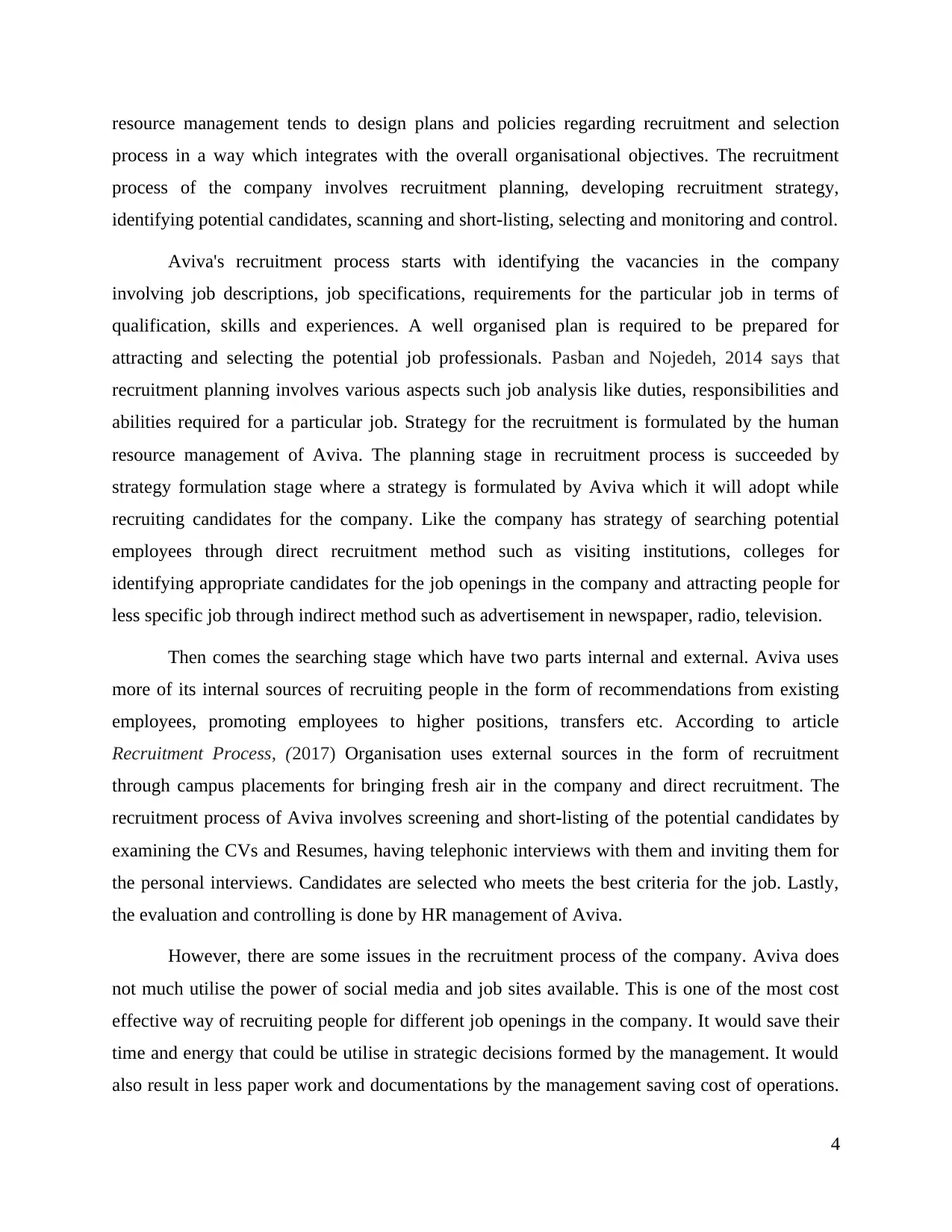
resource management tends to design plans and policies regarding recruitment and selection
process in a way which integrates with the overall organisational objectives. The recruitment
process of the company involves recruitment planning, developing recruitment strategy,
identifying potential candidates, scanning and short-listing, selecting and monitoring and control.
Aviva's recruitment process starts with identifying the vacancies in the company
involving job descriptions, job specifications, requirements for the particular job in terms of
qualification, skills and experiences. A well organised plan is required to be prepared for
attracting and selecting the potential job professionals. Pasban and Nojedeh, 2014 says that
recruitment planning involves various aspects such job analysis like duties, responsibilities and
abilities required for a particular job. Strategy for the recruitment is formulated by the human
resource management of Aviva. The planning stage in recruitment process is succeeded by
strategy formulation stage where a strategy is formulated by Aviva which it will adopt while
recruiting candidates for the company. Like the company has strategy of searching potential
employees through direct recruitment method such as visiting institutions, colleges for
identifying appropriate candidates for the job openings in the company and attracting people for
less specific job through indirect method such as advertisement in newspaper, radio, television.
Then comes the searching stage which have two parts internal and external. Aviva uses
more of its internal sources of recruiting people in the form of recommendations from existing
employees, promoting employees to higher positions, transfers etc. According to article
Recruitment Process, (2017) Organisation uses external sources in the form of recruitment
through campus placements for bringing fresh air in the company and direct recruitment. The
recruitment process of Aviva involves screening and short-listing of the potential candidates by
examining the CVs and Resumes, having telephonic interviews with them and inviting them for
the personal interviews. Candidates are selected who meets the best criteria for the job. Lastly,
the evaluation and controlling is done by HR management of Aviva.
However, there are some issues in the recruitment process of the company. Aviva does
not much utilise the power of social media and job sites available. This is one of the most cost
effective way of recruiting people for different job openings in the company. It would save their
time and energy that could be utilise in strategic decisions formed by the management. It would
also result in less paper work and documentations by the management saving cost of operations.
4
process in a way which integrates with the overall organisational objectives. The recruitment
process of the company involves recruitment planning, developing recruitment strategy,
identifying potential candidates, scanning and short-listing, selecting and monitoring and control.
Aviva's recruitment process starts with identifying the vacancies in the company
involving job descriptions, job specifications, requirements for the particular job in terms of
qualification, skills and experiences. A well organised plan is required to be prepared for
attracting and selecting the potential job professionals. Pasban and Nojedeh, 2014 says that
recruitment planning involves various aspects such job analysis like duties, responsibilities and
abilities required for a particular job. Strategy for the recruitment is formulated by the human
resource management of Aviva. The planning stage in recruitment process is succeeded by
strategy formulation stage where a strategy is formulated by Aviva which it will adopt while
recruiting candidates for the company. Like the company has strategy of searching potential
employees through direct recruitment method such as visiting institutions, colleges for
identifying appropriate candidates for the job openings in the company and attracting people for
less specific job through indirect method such as advertisement in newspaper, radio, television.
Then comes the searching stage which have two parts internal and external. Aviva uses
more of its internal sources of recruiting people in the form of recommendations from existing
employees, promoting employees to higher positions, transfers etc. According to article
Recruitment Process, (2017) Organisation uses external sources in the form of recruitment
through campus placements for bringing fresh air in the company and direct recruitment. The
recruitment process of Aviva involves screening and short-listing of the potential candidates by
examining the CVs and Resumes, having telephonic interviews with them and inviting them for
the personal interviews. Candidates are selected who meets the best criteria for the job. Lastly,
the evaluation and controlling is done by HR management of Aviva.
However, there are some issues in the recruitment process of the company. Aviva does
not much utilise the power of social media and job sites available. This is one of the most cost
effective way of recruiting people for different job openings in the company. It would save their
time and energy that could be utilise in strategic decisions formed by the management. It would
also result in less paper work and documentations by the management saving cost of operations.
4
Paraphrase This Document
Need a fresh take? Get an instant paraphrase of this document with our AI Paraphraser
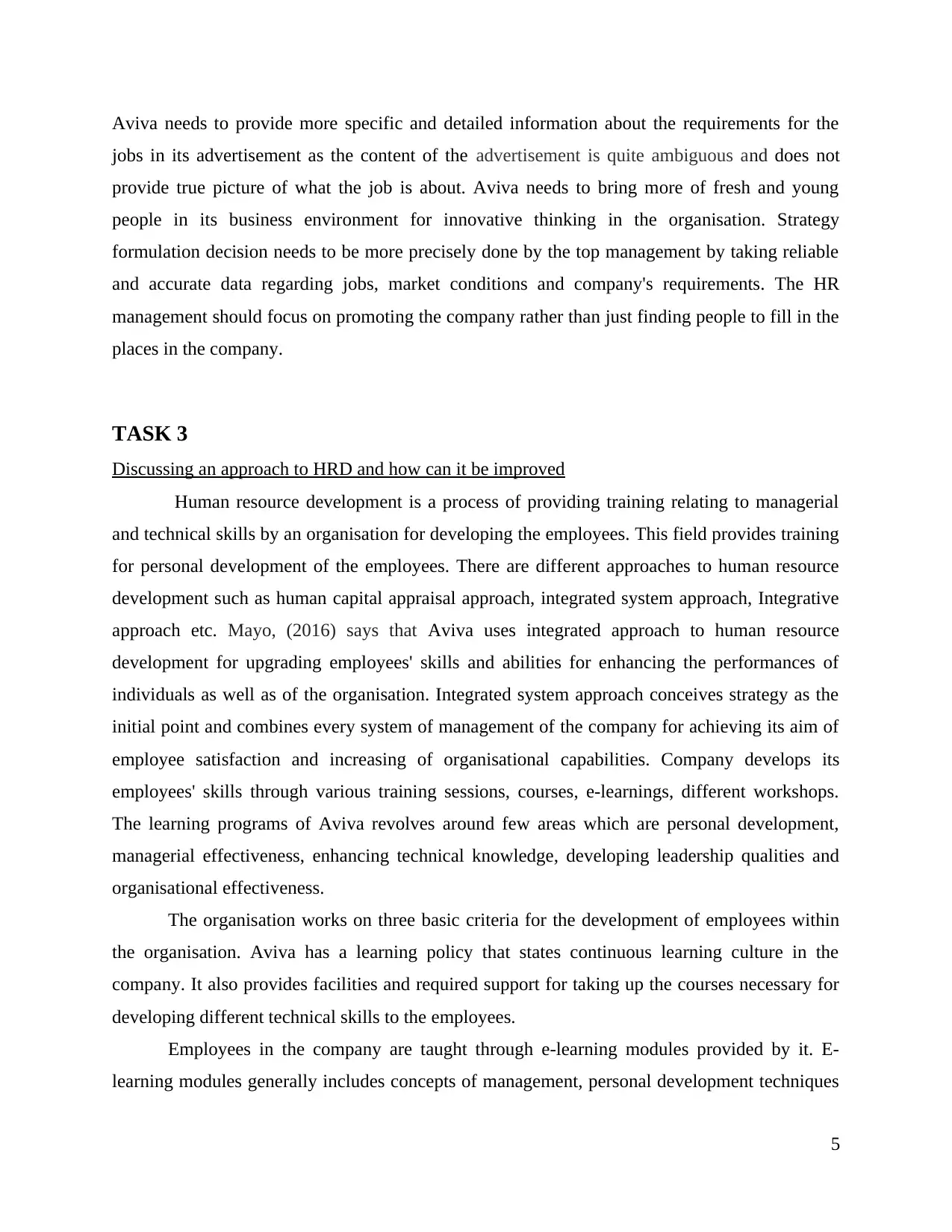
Aviva needs to provide more specific and detailed information about the requirements for the
jobs in its advertisement as the content of the advertisement is quite ambiguous and does not
provide true picture of what the job is about. Aviva needs to bring more of fresh and young
people in its business environment for innovative thinking in the organisation. Strategy
formulation decision needs to be more precisely done by the top management by taking reliable
and accurate data regarding jobs, market conditions and company's requirements. The HR
management should focus on promoting the company rather than just finding people to fill in the
places in the company.
TASK 3
Discussing an approach to HRD and how can it be improved
Human resource development is a process of providing training relating to managerial
and technical skills by an organisation for developing the employees. This field provides training
for personal development of the employees. There are different approaches to human resource
development such as human capital appraisal approach, integrated system approach, Integrative
approach etc. Mayo, (2016) says that Aviva uses integrated approach to human resource
development for upgrading employees' skills and abilities for enhancing the performances of
individuals as well as of the organisation. Integrated system approach conceives strategy as the
initial point and combines every system of management of the company for achieving its aim of
employee satisfaction and increasing of organisational capabilities. Company develops its
employees' skills through various training sessions, courses, e-learnings, different workshops.
The learning programs of Aviva revolves around few areas which are personal development,
managerial effectiveness, enhancing technical knowledge, developing leadership qualities and
organisational effectiveness.
The organisation works on three basic criteria for the development of employees within
the organisation. Aviva has a learning policy that states continuous learning culture in the
company. It also provides facilities and required support for taking up the courses necessary for
developing different technical skills to the employees.
Employees in the company are taught through e-learning modules provided by it. E-
learning modules generally includes concepts of management, personal development techniques
5
jobs in its advertisement as the content of the advertisement is quite ambiguous and does not
provide true picture of what the job is about. Aviva needs to bring more of fresh and young
people in its business environment for innovative thinking in the organisation. Strategy
formulation decision needs to be more precisely done by the top management by taking reliable
and accurate data regarding jobs, market conditions and company's requirements. The HR
management should focus on promoting the company rather than just finding people to fill in the
places in the company.
TASK 3
Discussing an approach to HRD and how can it be improved
Human resource development is a process of providing training relating to managerial
and technical skills by an organisation for developing the employees. This field provides training
for personal development of the employees. There are different approaches to human resource
development such as human capital appraisal approach, integrated system approach, Integrative
approach etc. Mayo, (2016) says that Aviva uses integrated approach to human resource
development for upgrading employees' skills and abilities for enhancing the performances of
individuals as well as of the organisation. Integrated system approach conceives strategy as the
initial point and combines every system of management of the company for achieving its aim of
employee satisfaction and increasing of organisational capabilities. Company develops its
employees' skills through various training sessions, courses, e-learnings, different workshops.
The learning programs of Aviva revolves around few areas which are personal development,
managerial effectiveness, enhancing technical knowledge, developing leadership qualities and
organisational effectiveness.
The organisation works on three basic criteria for the development of employees within
the organisation. Aviva has a learning policy that states continuous learning culture in the
company. It also provides facilities and required support for taking up the courses necessary for
developing different technical skills to the employees.
Employees in the company are taught through e-learning modules provided by it. E-
learning modules generally includes concepts of management, personal development techniques
5
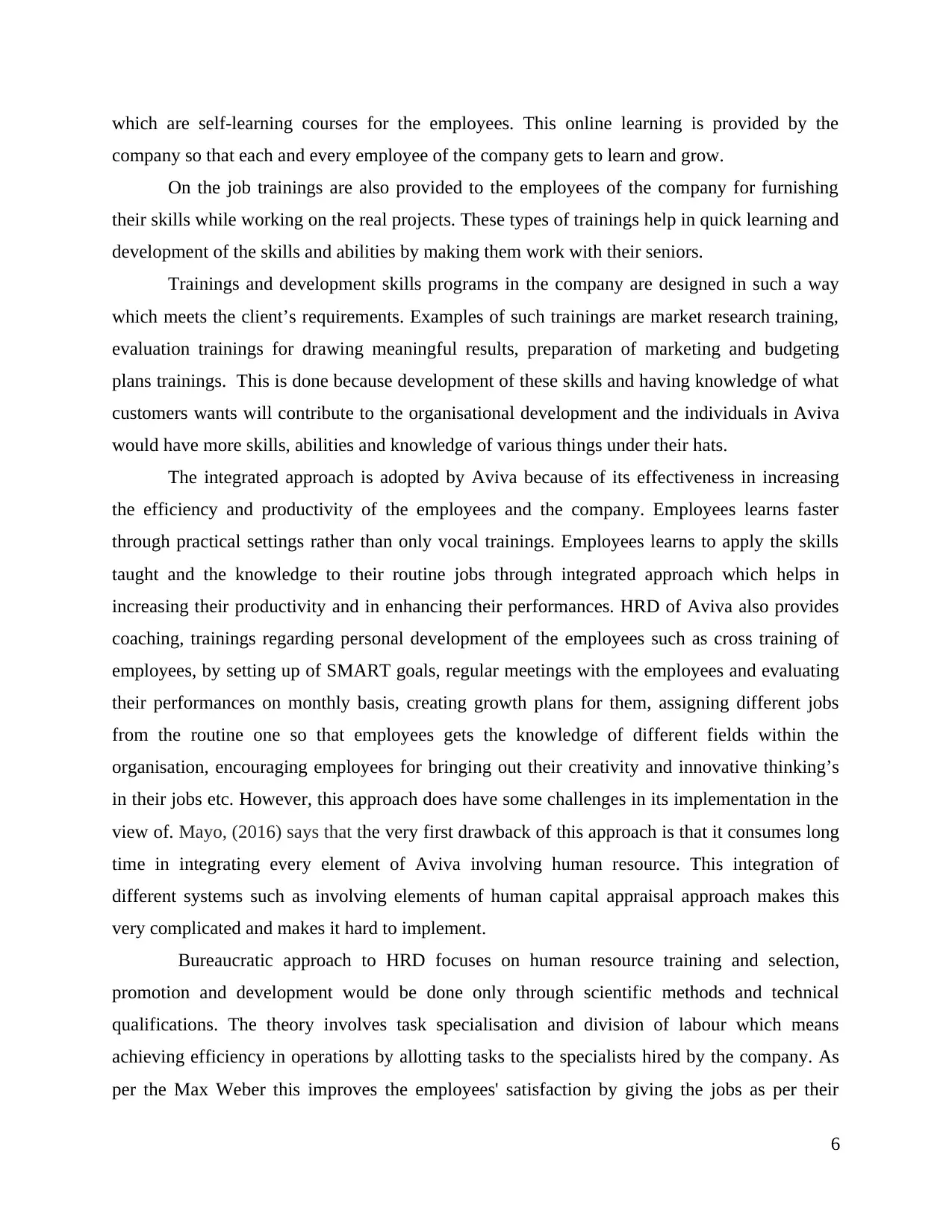
which are self-learning courses for the employees. This online learning is provided by the
company so that each and every employee of the company gets to learn and grow.
On the job trainings are also provided to the employees of the company for furnishing
their skills while working on the real projects. These types of trainings help in quick learning and
development of the skills and abilities by making them work with their seniors.
Trainings and development skills programs in the company are designed in such a way
which meets the client’s requirements. Examples of such trainings are market research training,
evaluation trainings for drawing meaningful results, preparation of marketing and budgeting
plans trainings. This is done because development of these skills and having knowledge of what
customers wants will contribute to the organisational development and the individuals in Aviva
would have more skills, abilities and knowledge of various things under their hats.
The integrated approach is adopted by Aviva because of its effectiveness in increasing
the efficiency and productivity of the employees and the company. Employees learns faster
through practical settings rather than only vocal trainings. Employees learns to apply the skills
taught and the knowledge to their routine jobs through integrated approach which helps in
increasing their productivity and in enhancing their performances. HRD of Aviva also provides
coaching, trainings regarding personal development of the employees such as cross training of
employees, by setting up of SMART goals, regular meetings with the employees and evaluating
their performances on monthly basis, creating growth plans for them, assigning different jobs
from the routine one so that employees gets the knowledge of different fields within the
organisation, encouraging employees for bringing out their creativity and innovative thinking’s
in their jobs etc. However, this approach does have some challenges in its implementation in the
view of. Mayo, (2016) says that the very first drawback of this approach is that it consumes long
time in integrating every element of Aviva involving human resource. This integration of
different systems such as involving elements of human capital appraisal approach makes this
very complicated and makes it hard to implement.
Bureaucratic approach to HRD focuses on human resource training and selection,
promotion and development would be done only through scientific methods and technical
qualifications. The theory involves task specialisation and division of labour which means
achieving efficiency in operations by allotting tasks to the specialists hired by the company. As
per the Max Weber this improves the employees' satisfaction by giving the jobs as per their
6
company so that each and every employee of the company gets to learn and grow.
On the job trainings are also provided to the employees of the company for furnishing
their skills while working on the real projects. These types of trainings help in quick learning and
development of the skills and abilities by making them work with their seniors.
Trainings and development skills programs in the company are designed in such a way
which meets the client’s requirements. Examples of such trainings are market research training,
evaluation trainings for drawing meaningful results, preparation of marketing and budgeting
plans trainings. This is done because development of these skills and having knowledge of what
customers wants will contribute to the organisational development and the individuals in Aviva
would have more skills, abilities and knowledge of various things under their hats.
The integrated approach is adopted by Aviva because of its effectiveness in increasing
the efficiency and productivity of the employees and the company. Employees learns faster
through practical settings rather than only vocal trainings. Employees learns to apply the skills
taught and the knowledge to their routine jobs through integrated approach which helps in
increasing their productivity and in enhancing their performances. HRD of Aviva also provides
coaching, trainings regarding personal development of the employees such as cross training of
employees, by setting up of SMART goals, regular meetings with the employees and evaluating
their performances on monthly basis, creating growth plans for them, assigning different jobs
from the routine one so that employees gets the knowledge of different fields within the
organisation, encouraging employees for bringing out their creativity and innovative thinking’s
in their jobs etc. However, this approach does have some challenges in its implementation in the
view of. Mayo, (2016) says that the very first drawback of this approach is that it consumes long
time in integrating every element of Aviva involving human resource. This integration of
different systems such as involving elements of human capital appraisal approach makes this
very complicated and makes it hard to implement.
Bureaucratic approach to HRD focuses on human resource training and selection,
promotion and development would be done only through scientific methods and technical
qualifications. The theory involves task specialisation and division of labour which means
achieving efficiency in operations by allotting tasks to the specialists hired by the company. As
per the Max Weber this improves the employees' satisfaction by giving the jobs as per their
6
⊘ This is a preview!⊘
Do you want full access?
Subscribe today to unlock all pages.

Trusted by 1+ million students worldwide
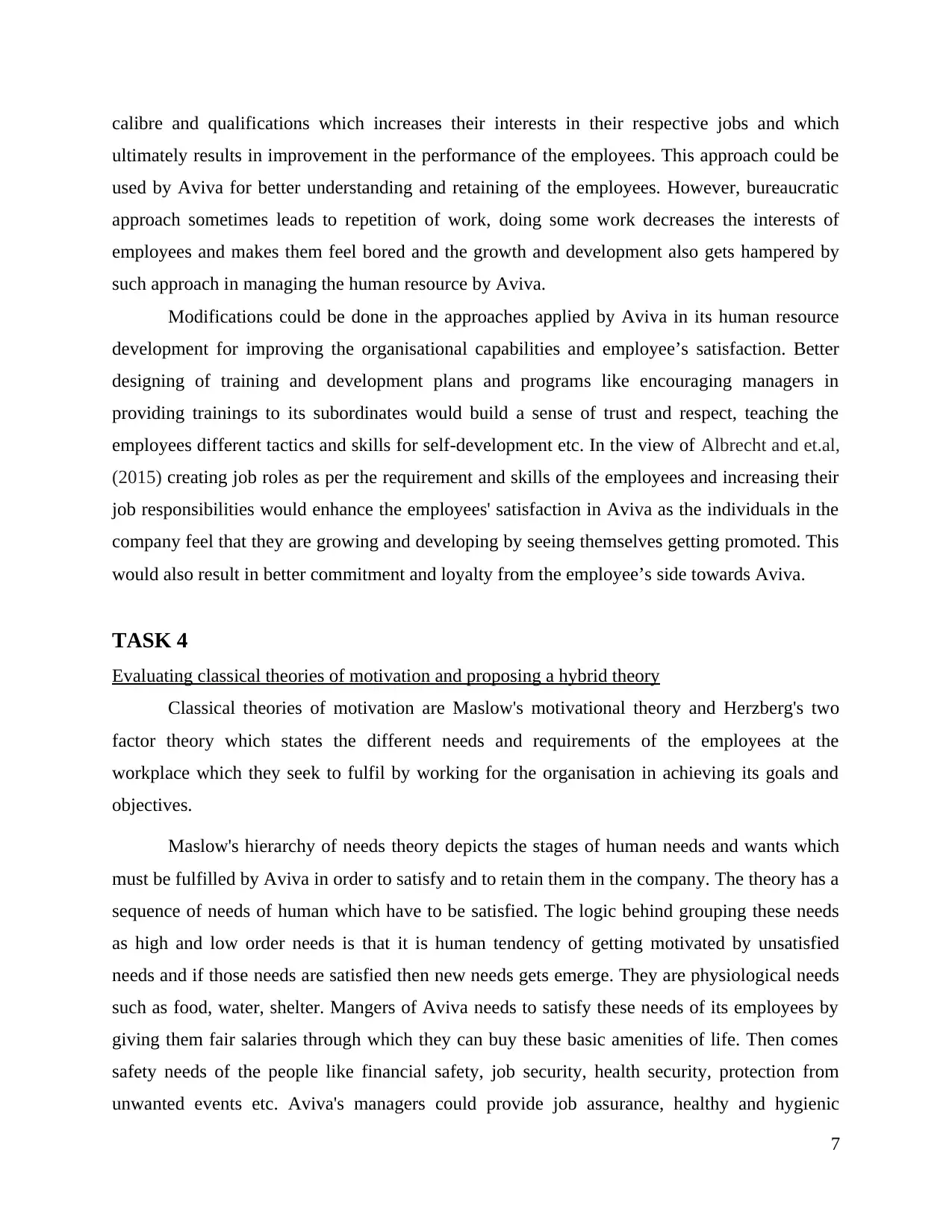
calibre and qualifications which increases their interests in their respective jobs and which
ultimately results in improvement in the performance of the employees. This approach could be
used by Aviva for better understanding and retaining of the employees. However, bureaucratic
approach sometimes leads to repetition of work, doing some work decreases the interests of
employees and makes them feel bored and the growth and development also gets hampered by
such approach in managing the human resource by Aviva.
Modifications could be done in the approaches applied by Aviva in its human resource
development for improving the organisational capabilities and employee’s satisfaction. Better
designing of training and development plans and programs like encouraging managers in
providing trainings to its subordinates would build a sense of trust and respect, teaching the
employees different tactics and skills for self-development etc. In the view of Albrecht and et.al,
(2015) creating job roles as per the requirement and skills of the employees and increasing their
job responsibilities would enhance the employees' satisfaction in Aviva as the individuals in the
company feel that they are growing and developing by seeing themselves getting promoted. This
would also result in better commitment and loyalty from the employee’s side towards Aviva.
TASK 4
Evaluating classical theories of motivation and proposing a hybrid theory
Classical theories of motivation are Maslow's motivational theory and Herzberg's two
factor theory which states the different needs and requirements of the employees at the
workplace which they seek to fulfil by working for the organisation in achieving its goals and
objectives.
Maslow's hierarchy of needs theory depicts the stages of human needs and wants which
must be fulfilled by Aviva in order to satisfy and to retain them in the company. The theory has a
sequence of needs of human which have to be satisfied. The logic behind grouping these needs
as high and low order needs is that it is human tendency of getting motivated by unsatisfied
needs and if those needs are satisfied then new needs gets emerge. They are physiological needs
such as food, water, shelter. Mangers of Aviva needs to satisfy these needs of its employees by
giving them fair salaries through which they can buy these basic amenities of life. Then comes
safety needs of the people like financial safety, job security, health security, protection from
unwanted events etc. Aviva's managers could provide job assurance, healthy and hygienic
7
ultimately results in improvement in the performance of the employees. This approach could be
used by Aviva for better understanding and retaining of the employees. However, bureaucratic
approach sometimes leads to repetition of work, doing some work decreases the interests of
employees and makes them feel bored and the growth and development also gets hampered by
such approach in managing the human resource by Aviva.
Modifications could be done in the approaches applied by Aviva in its human resource
development for improving the organisational capabilities and employee’s satisfaction. Better
designing of training and development plans and programs like encouraging managers in
providing trainings to its subordinates would build a sense of trust and respect, teaching the
employees different tactics and skills for self-development etc. In the view of Albrecht and et.al,
(2015) creating job roles as per the requirement and skills of the employees and increasing their
job responsibilities would enhance the employees' satisfaction in Aviva as the individuals in the
company feel that they are growing and developing by seeing themselves getting promoted. This
would also result in better commitment and loyalty from the employee’s side towards Aviva.
TASK 4
Evaluating classical theories of motivation and proposing a hybrid theory
Classical theories of motivation are Maslow's motivational theory and Herzberg's two
factor theory which states the different needs and requirements of the employees at the
workplace which they seek to fulfil by working for the organisation in achieving its goals and
objectives.
Maslow's hierarchy of needs theory depicts the stages of human needs and wants which
must be fulfilled by Aviva in order to satisfy and to retain them in the company. The theory has a
sequence of needs of human which have to be satisfied. The logic behind grouping these needs
as high and low order needs is that it is human tendency of getting motivated by unsatisfied
needs and if those needs are satisfied then new needs gets emerge. They are physiological needs
such as food, water, shelter. Mangers of Aviva needs to satisfy these needs of its employees by
giving them fair salaries through which they can buy these basic amenities of life. Then comes
safety needs of the people like financial safety, job security, health security, protection from
unwanted events etc. Aviva's managers could provide job assurance, healthy and hygienic
7
Paraphrase This Document
Need a fresh take? Get an instant paraphrase of this document with our AI Paraphraser
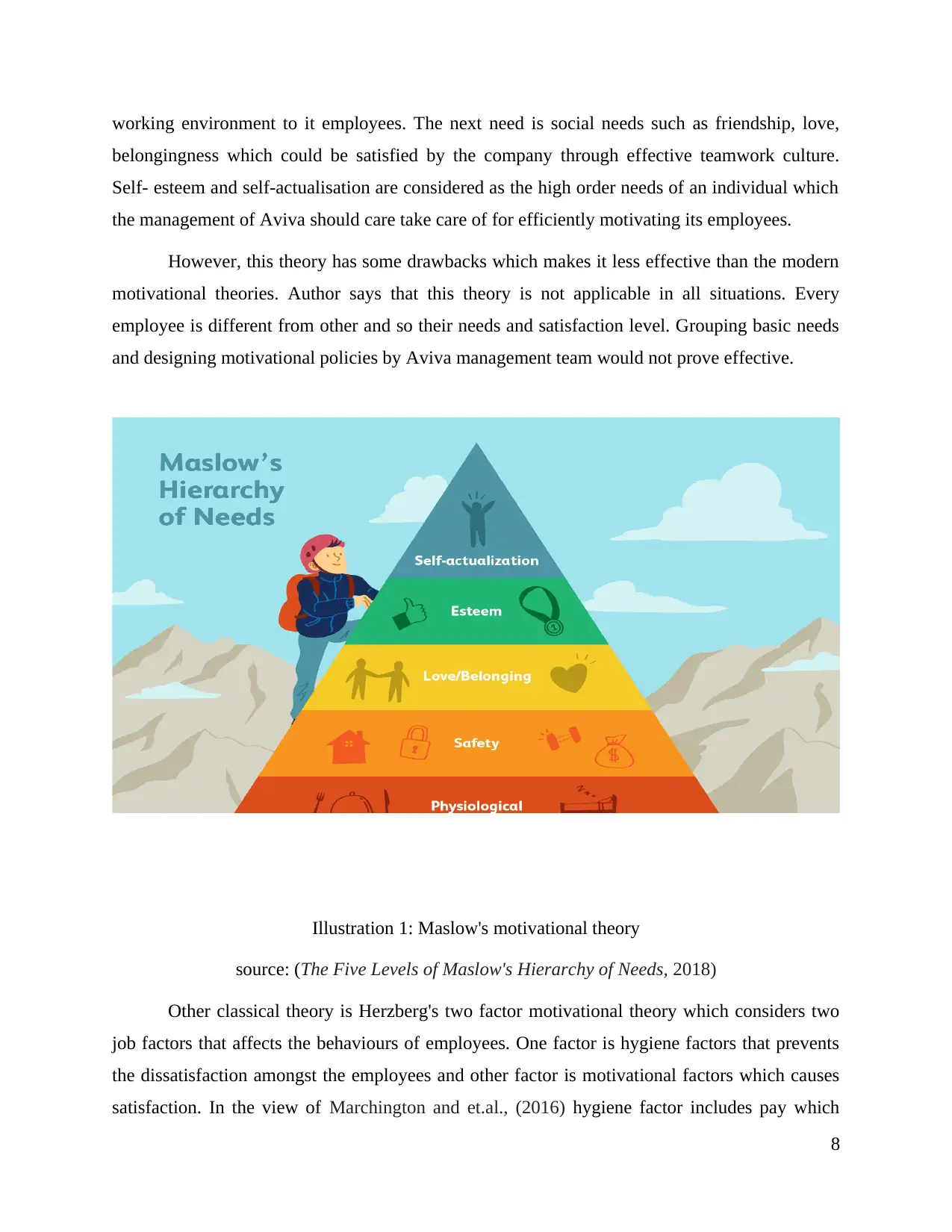
working environment to it employees. The next need is social needs such as friendship, love,
belongingness which could be satisfied by the company through effective teamwork culture.
Self- esteem and self-actualisation are considered as the high order needs of an individual which
the management of Aviva should care take care of for efficiently motivating its employees.
However, this theory has some drawbacks which makes it less effective than the modern
motivational theories. Author says that this theory is not applicable in all situations. Every
employee is different from other and so their needs and satisfaction level. Grouping basic needs
and designing motivational policies by Aviva management team would not prove effective.
Illustration 1: Maslow's motivational theory
source: (The Five Levels of Maslow's Hierarchy of Needs, 2018)
Other classical theory is Herzberg's two factor motivational theory which considers two
job factors that affects the behaviours of employees. One factor is hygiene factors that prevents
the dissatisfaction amongst the employees and other factor is motivational factors which causes
satisfaction. In the view of Marchington and et.al., (2016) hygiene factor includes pay which
8
belongingness which could be satisfied by the company through effective teamwork culture.
Self- esteem and self-actualisation are considered as the high order needs of an individual which
the management of Aviva should care take care of for efficiently motivating its employees.
However, this theory has some drawbacks which makes it less effective than the modern
motivational theories. Author says that this theory is not applicable in all situations. Every
employee is different from other and so their needs and satisfaction level. Grouping basic needs
and designing motivational policies by Aviva management team would not prove effective.
Illustration 1: Maslow's motivational theory
source: (The Five Levels of Maslow's Hierarchy of Needs, 2018)
Other classical theory is Herzberg's two factor motivational theory which considers two
job factors that affects the behaviours of employees. One factor is hygiene factors that prevents
the dissatisfaction amongst the employees and other factor is motivational factors which causes
satisfaction. In the view of Marchington and et.al., (2016) hygiene factor includes pay which
8
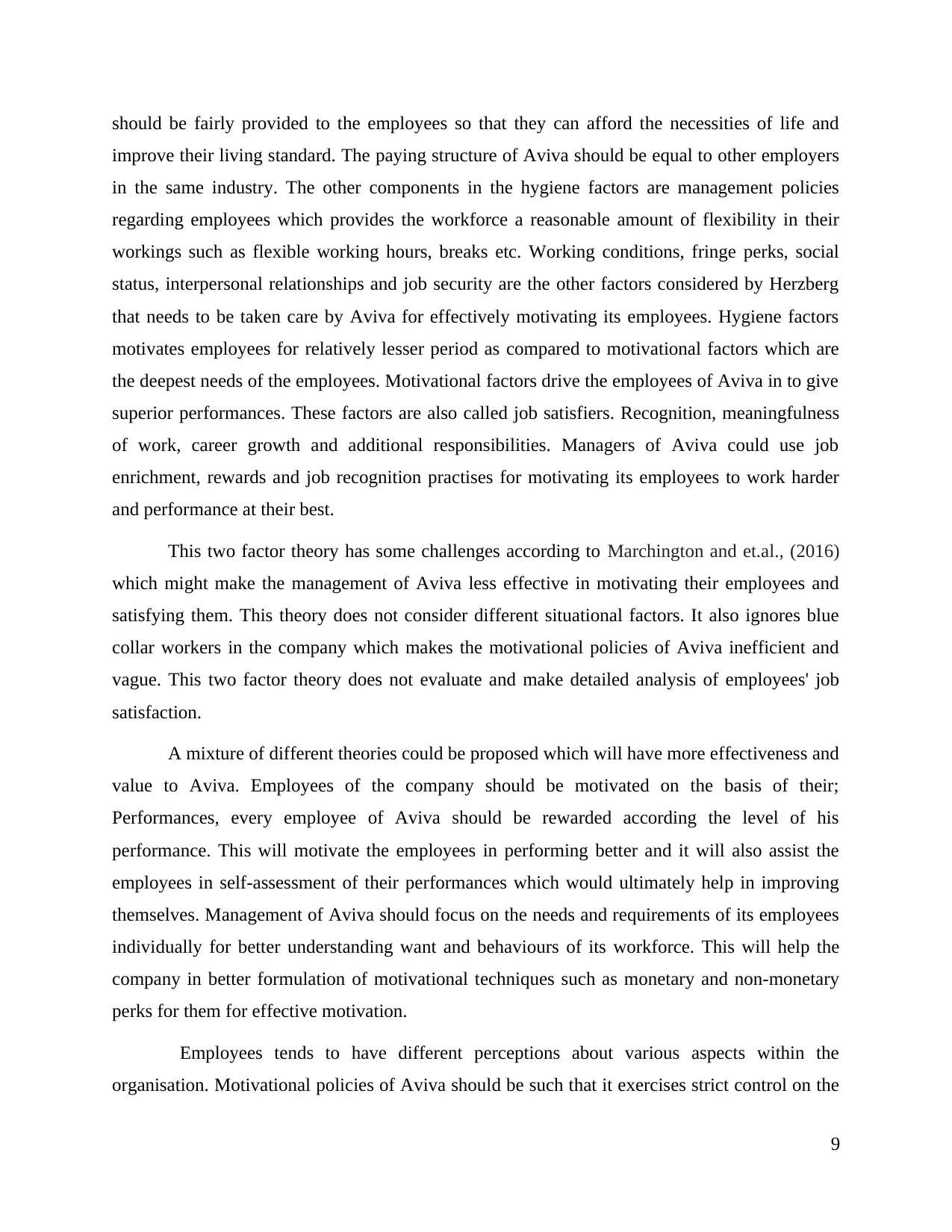
should be fairly provided to the employees so that they can afford the necessities of life and
improve their living standard. The paying structure of Aviva should be equal to other employers
in the same industry. The other components in the hygiene factors are management policies
regarding employees which provides the workforce a reasonable amount of flexibility in their
workings such as flexible working hours, breaks etc. Working conditions, fringe perks, social
status, interpersonal relationships and job security are the other factors considered by Herzberg
that needs to be taken care by Aviva for effectively motivating its employees. Hygiene factors
motivates employees for relatively lesser period as compared to motivational factors which are
the deepest needs of the employees. Motivational factors drive the employees of Aviva in to give
superior performances. These factors are also called job satisfiers. Recognition, meaningfulness
of work, career growth and additional responsibilities. Managers of Aviva could use job
enrichment, rewards and job recognition practises for motivating its employees to work harder
and performance at their best.
This two factor theory has some challenges according to Marchington and et.al., (2016)
which might make the management of Aviva less effective in motivating their employees and
satisfying them. This theory does not consider different situational factors. It also ignores blue
collar workers in the company which makes the motivational policies of Aviva inefficient and
vague. This two factor theory does not evaluate and make detailed analysis of employees' job
satisfaction.
A mixture of different theories could be proposed which will have more effectiveness and
value to Aviva. Employees of the company should be motivated on the basis of their;
Performances, every employee of Aviva should be rewarded according the level of his
performance. This will motivate the employees in performing better and it will also assist the
employees in self-assessment of their performances which would ultimately help in improving
themselves. Management of Aviva should focus on the needs and requirements of its employees
individually for better understanding want and behaviours of its workforce. This will help the
company in better formulation of motivational techniques such as monetary and non-monetary
perks for them for effective motivation.
Employees tends to have different perceptions about various aspects within the
organisation. Motivational policies of Aviva should be such that it exercises strict control on the
9
improve their living standard. The paying structure of Aviva should be equal to other employers
in the same industry. The other components in the hygiene factors are management policies
regarding employees which provides the workforce a reasonable amount of flexibility in their
workings such as flexible working hours, breaks etc. Working conditions, fringe perks, social
status, interpersonal relationships and job security are the other factors considered by Herzberg
that needs to be taken care by Aviva for effectively motivating its employees. Hygiene factors
motivates employees for relatively lesser period as compared to motivational factors which are
the deepest needs of the employees. Motivational factors drive the employees of Aviva in to give
superior performances. These factors are also called job satisfiers. Recognition, meaningfulness
of work, career growth and additional responsibilities. Managers of Aviva could use job
enrichment, rewards and job recognition practises for motivating its employees to work harder
and performance at their best.
This two factor theory has some challenges according to Marchington and et.al., (2016)
which might make the management of Aviva less effective in motivating their employees and
satisfying them. This theory does not consider different situational factors. It also ignores blue
collar workers in the company which makes the motivational policies of Aviva inefficient and
vague. This two factor theory does not evaluate and make detailed analysis of employees' job
satisfaction.
A mixture of different theories could be proposed which will have more effectiveness and
value to Aviva. Employees of the company should be motivated on the basis of their;
Performances, every employee of Aviva should be rewarded according the level of his
performance. This will motivate the employees in performing better and it will also assist the
employees in self-assessment of their performances which would ultimately help in improving
themselves. Management of Aviva should focus on the needs and requirements of its employees
individually for better understanding want and behaviours of its workforce. This will help the
company in better formulation of motivational techniques such as monetary and non-monetary
perks for them for effective motivation.
Employees tends to have different perceptions about various aspects within the
organisation. Motivational policies of Aviva should be such that it exercises strict control on the
9
⊘ This is a preview!⊘
Do you want full access?
Subscribe today to unlock all pages.

Trusted by 1+ million students worldwide
1 out of 17
Related Documents
Your All-in-One AI-Powered Toolkit for Academic Success.
+13062052269
info@desklib.com
Available 24*7 on WhatsApp / Email
![[object Object]](/_next/static/media/star-bottom.7253800d.svg)
Unlock your academic potential
Copyright © 2020–2025 A2Z Services. All Rights Reserved. Developed and managed by ZUCOL.



